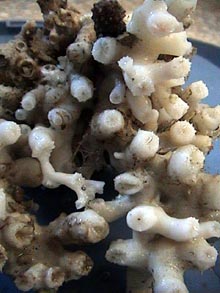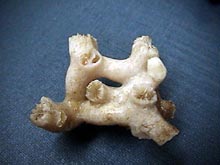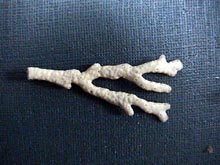
This specimen is the largest colonial coral collected to date. Large corals provide essential habitat for a number of other organisms, including the tiny black anemone at the top center of this image. Image courtesy of Project Oceanica. Click image for larger view.
Branching Out: How do Deep-water Corals Grow?
August 6, 2003
Fred Andrus, Geologist
Savannah River Ecology Laboratory
University of Georgia
Getting back on track -- that’s the theme for today. After losing valuable dives to nasty weather, seasickness, and crazy currents, we all felt we deserved a productive day of work. That’s exactly what we got!
Dave Wyanski and Phil Weinbach, both fish biologists at the South Carolina Dept. of Natural Resources, returned to the Johnson-Sea-Link II submersible after yesterday's disappointing 30-sec stay on the bottom (see Aug. 5 log). Their perseverance was rewarded with a breathtaking and rewarding dive at a target site with higher relief than any of the other dives to date. Good fortune continued for the researchers on the afternoon dive. Today’s dives provided the best deep-water coral samples for this expedition to date.
Coral is typically thought of as a shallow-water creature that exists in tropical waters near coastal regions. These reefs are bathed in sunlight that passes through clear waters to feed the symbiotic algae that live within each polyp throughout the colonies that form the reef. This algae, in turn, feeds the coral itself.
This image is true of many corals, but there are other types, less obvious, but nonetheless abundant, that form important parts of marine ecosystems. In deeper and cooler waters, below the reach of the sun, these corals feed by filtering microorganisms from the water that flows past. The corals attach to hard surfaces that are abundant here at the Charleston Bump, reaching higher into the current, with colonial species sometimes forming branching structures that provide habitat for a variety of other organisms. Other solitary species live more inconspicuously. Even this early in the expedition, we have examples of both colonial and solitary forms.

A close-up of some of the individual polyps that comprise a colonial coral. Image courtesy of Project Oceanica. Click image for larger view.

This image from today's dive provides a great example of the abundant coral growth that can be found in some areas with exposed hard bottom. Corals provide essential habitat for a number of other organisms. Click image for larger view.
Ecosystems in which deep-water coral is a critical component are increasingly significant to people as sources of food fish, such as the wreckfish here at the Charleston Bump. Additionally, the skeletons of the coral contain chemical measures of the environment and climate in which it grew. Older corals, from both deep and shallow water, may give key insights into potential climate variations from time periods older than our instrumental records permit. Therefore, the study of these corals can contribute significantly to the understanding of phenomena critical to us today.
Coral skeletons are composed of calcium carbonate (CaCO3) in the form of aragonite. Each polyp, containing the living soft tissue of the organism, precipitates this mineral to form a protective skeleton. As the coral grows and adds new skeleton, the older skeleton remains as the foundation of the structure, creating a historical record of growth. In many organisms that grow throughout their lives, including coral, growth rates vary depending on several conditions, such as nutrient availability and temperature. Sometimes these periods of alternating faster and slower growth produce banding, not unlike tree rings. Corals contain similar growth bands, often called density bands. In corals that live near the surface, these bands commonly occur annually, and thus, can be used to measure time. In deep-water corals, however, the growth rings occur in response to variables that are not yet fully understood, and possibly at variable intervals. As a result, other methods are needed to determine how fast a deep-water coral grows.

These small, tree-shaped coral are common on the exposed rock of the Charleston Bump. Image courtesy of Project Oceanica. Click image for larger view.
In order to grow a skeleton, coral utilizes dissolved materials from the surrounding seawater. As the coral is producing its skeleton, it also incorporates other elements that may not be necessary to form aragonite. The abundance of some of these elements is a function of the environment surrounding the coral, and others are a function of metabolism. Sometimes it is a combination of both factors. If the elements are measured in the skeleton of a coral from the oldest parts and from those most recently produced, a picture of the variable chemical environment, and possibly the coral's life history, can be reconstructed. If the elements vary seasonally in the water, they may also vary in the coral as it grows. These cycles can be used to measure time if they occur in regular, known rhythms. One of the purposes of the coral collections in this expedition is to help us understand the factors controlling the distribution of these elements in coral skeletons so that we may better define the natural history of these organisms, and, by extension, the ecosystems within which they dwell.
























